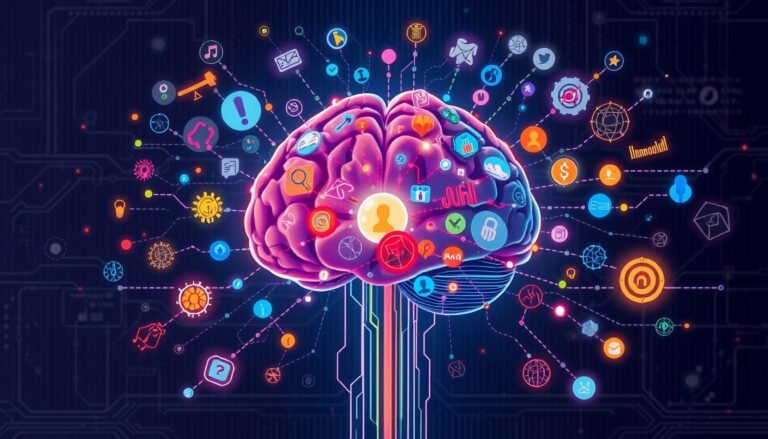Best AI applications
Artificial intelligence is changing our world fast. We’re on the edge of an AI revolution, and a big question is: Are we ready for AI’s power? The AI software market is expected to grow to $126 billion by 2025. This growth is bringing a new era of digital change to many industries.
AI is now a big part of our lives. Chatbots help with customer support, and image editors can change selfies quickly. These AI tools are changing how we work and play, and how we interact with computers.
AI isn’t just for big companies. Small businesses and individuals can use AI tools like FaceApp and Lensa AI. These tools offer over 60 AI filters and can remove objects from photos easily. Even our homes are getting smarter, thanks to AI assistants like Google Assistant that can do tasks with voice commands.
Key Takeaways
- The AI software market is projected to reach $126 billion by 2025
- AI applications span various sectors, from e-commerce to healthcare
- Chatbots and virtual assistants are revolutionizing customer service
- AI-powered image editing tools are transforming personal and professional photography
- Voice-activated AI assistants are making home automation more accessible
- AI is enhancing educational experiences through personalized learning platforms
- The ethical implications of AI adoption require careful consideration
Introduction to AI Applications
AI applications are changing our digital world. They use AI software to automate tasks that humans used to do. This is transforming how we work and interact with technology in many fields.
What are AI Applications?
AI applications are platforms that use artificial intelligence to do complex tasks. They use natural language processing and machine learning to understand and respond to us. Examples include chatbots and image generators, which are now key parts of our daily lives.
The Growing Importance of AI
In today’s fast world, AI applications are key. They make workflows smoother and increase productivity. A recent survey found that 82% of tech leaders plan to invest more in AI next year. This shows AI’s growing role in business strategies.
AI’s Journey Through Time
AI has made huge progress. It started with simple systems and now we have advanced deep learning models. These new models allow for more human-like interactions. Today, AI can write code, analyze data, and even create art. It’s a big leap from its early days.
“AI is not just a tool; it’s a transformative force shaping our future.”
As AI keeps evolving, its uses will expand and become more significant. It will change healthcare, finance, and many other areas of our lives. The journey of AI applications is just starting, and the future looks bright.
The Rise of Chatbots and Conversational AI
AI chatbots have changed how we talk to companies. The market for conversational AI is expected to hit $32.6 billion by 2030. This shows a big change in how businesses talk to customers. It’s because more industries are using natural language understanding.
Now, we see AI assistants like Apple’s Siri and Amazon’s Alexa everywhere. They help with everything from personal tasks to controlling our homes. They give us information that’s just for us, making them key in our daily lives.
Companies are using AI chatbots to make customer service better. These smart systems can quickly answer simple questions. This saves time and makes service better. Unlike old chatbots, AI ones get better at understanding us over time.
“Conversational AI is transforming customer service, reducing wait times, and providing personalized solutions at scale.”
By combining conversational AI with customer relationship management, companies can give more personalized advice. This also helps them collect important customer data during chats.
| Feature | Traditional Chatbots | AI-Powered Chatbots |
|---|---|---|
| Response Mechanism | Predefined rules | Natural language understanding |
| Adaptability | Manual updates required | Learns from interactions |
| Complexity Handling | Limited to simple queries | Can handle complex questions |
| Personalization | Limited | High, improves over time |
Conversational AI is getting better and will be used more in customer service, data analysis, and personal help. It can have real conversations and get better with time. This makes it a great tool for businesses wanting to improve how they talk to customers and work more efficiently.
AI in Image Generation and Editing
AI image generation has grown a lot in recent years. Now, creative AI tools give artists and designers new powers. They can make and change visual content in ways we never thought possible.
DALL·E 3: Revolutionizing Image Creation
DALL·E 3 is leading the way in AI image making. It turns text prompts into amazing visuals with incredible detail. This tool is changing what we think digital art can be.
Midjourney: Artistic AI-Generated Visuals
Midjourney is known for its artistic touch in AI images. It makes unique, stylized pictures that feel like they’re from another world. Artists love it for its ability to surprise and inspire with simple text prompts.
Stable Diffusion: Open-Source Image Generation
Stable Diffusion is a big step forward in open-source AI image making. It lets users make different images from text, offering lots of options. Its open nature has brought together a community of developers who keep making it better.
These AI tools are changing many industries. They help make blog post images and storyboards, among other things. As they get better, we’ll see even more amazing and realistic visuals. This will open up new ways for creativity and innovation in making visual content.
| AI Tool | Key Feature | Best For |
|---|---|---|
| DALL·E 3 | Accurate text interpretation | Detailed, realistic images |
| Midjourney | Artistic style | Creative, unique visuals |
| Stable Diffusion | Open-source flexibility | Customizable image generation |
Natural Language Processing Tools
Natural Language Processing (NLP) tools have changed how we understand and analyze language. These AI-powered writing assistants bring advanced features to improve communication.
Platforms like Grammarly, Wordtune, and ProWritingAid lead in language improvement. Grammarly is great at checking grammar and style. Wordtune offers different word choices and sentence rewrites. ProWritingAid does it all, with grammar, style, and spelling checks, plus detailed stats to enhance your writing.
- MonkeyLearn and spaCy for versatile text analysis
- Stanford CoreNLP supporting 8 natural languages
- Amazon Comprehend for syntax analysis and entity detection
- OpenAI and Microsoft Azure for large-scale language model exploration
Google Cloud Natural Language API is notable for its support of many languages. It offers detailed features like sentiment analysis and content classification. BERT (Bidirectional Encoder Representations from Transformers) uses cutting-edge methods for top NLP results.
| NLP Tool | Key Features | Pricing |
|---|---|---|
| Amazon Comprehend | Syntax analysis, entity detection | $3 per hour for training |
| OpenAI | Large-scale language model exploration | $20 per month API access |
| Microsoft Azure | AI on NLP services | $200 for 12 months |
| Google Cloud | 20 free products | $300 plus free tier |
These NLP tools help businesses and individuals use AI for better language understanding and text analysis. They make communication more effective in our digital world.
Best AI Applications for Content Creation
AI content creation tools are changing how we write. They make copywriting faster and easier for marketers and writers. Let’s look at some top AI writing assistants that are changing how we automate writing.
Jasper: AI-powered Writing Assistant
Jasper is a top choice for making lots of content fast. It has many templates and can even make images. With Jasper, you can write blog posts, social media, and marketing copy much quicker than by hand.
Copy.ai: Streamlining Copywriting Tasks
Copy.ai helps you write by offering many options to choose from. It’s great for making headlines, product descriptions, and ad copy. Using Copy.ai can save a lot of time on writing the same things over and over.
Anyword: Marketing-focused Content Generation
Anyword is all about marketing content. It helps you create titles, outlines, and final content. It uses data to make your copy better at getting results, which is key for marketing.
These AI tools work with other apps through Zapier, making content creation easier. With over 75% of marketers using AI, it’s clear these tools are key for digital marketing.
“AI content creation tools have revolutionized our marketing strategy, allowing us to produce high-quality content at scale while maintaining our brand voice.”
The cost of AI content varies, but it’s often cheaper than hiring a freelancer. For example, a 1,500-word article might cost under $175. As these tools get better, they’ll be even more important for marketing and content creation.
AI-Powered Virtual Assistants
AI-powered virtual assistants are now a big part of our lives. They use voice recognition to understand and act on our commands. They can search the internet and control smart home devices. Examples include Google Assistant, Amazon’s Alexa, and Apple’s Siri.
Google Assistant is special because it works with thousands of smart home devices. It even has experimental features like Gemini AI for more help. Alexa, launched in 2014, works well with Amazon Echo speakers and smart home devices. Siri, introduced in 2011, is on all Apple products like iPhones and MacBooks.
Despite their progress, these assistants still have challenges. A study by Carnegie Mellon University found they only succeed 16% of the time, compared to humans at 88%. They often struggle with tasks like navigating websites and getting stuck in loops.
| Virtual Assistant | Launch Year | Key Features |
|---|---|---|
| Google Assistant | 2016 | Compatible with 1,000+ brands, Gemini AI |
| Amazon Alexa | 2014 | Works with Echo speakers, smart home control |
| Apple Siri | 2011 | Available on all Apple devices |
The future of AI assistants is bright. Companies like Apple, Microsoft, and Google are making them smarter. They want to do more than just simple tasks. They aim to solve complex problems, changing how we talk to computers.
Machine Learning in Predictive Analytics
Machine learning is changing predictive analytics in many fields. It uses data to predict trends and make smart choices. Let’s see how it’s changing finance, how people shop, and supply chain management.
Applications in Finance and Business
In finance, machine learning spots risks and fraud. Banks use AI to check transactions and find odd ones. Businesses use it to understand market trends, getting ahead of the game.
AI for Consumer Behavior Prediction
AI is great at guessing what people will buy. It looks at what they’ve bought before and what they browse. This helps companies make ads that really speak to their customers, boosting sales and happiness.
Enhancing Supply Chain Management
AI is making supply chains smarter. It predicts what will be needed and when, and makes logistics better. This cuts costs and makes things run smoother.
| Application | Benefits | Key Techniques |
|---|---|---|
| Finance | Risk assessment, Fraud detection | Logistic regression, Neural networks |
| Consumer Behavior | Targeted marketing, Personalization | Clustering, Decision trees |
| Supply Chain | Inventory optimization, Demand forecasting | Time series analysis, Random forests |
As companies use AI, they make better choices and run more smoothly. The future of predictive analytics is exciting, with AI getting even better at helping us.
AI Applications in Healthcare
Medical AI is changing healthcare in big ways. It offers new solutions for patients and doctors. AI helps with everything from diagnosing diseases to analyzing health data.
Apps like Noom use AI to help people lose weight. SkinVision helps spot skin cancer early. These tools are making a big difference.
AI is also improving medical tools. Binah.ai lets people check vital signs with a smartphone. Enlitic’s AI tools make reading X-rays easier. This is important because many patients get hurt in hospitals.
AI is also making healthcare data analysis better. Cohere Health is making it easier to get medical care. Pfizer and Takeda are using AI to develop new drugs. AI is making healthcare more efficient and accurate.
Source Links
- What are the Best AI Apps in 2024?
- 24 Cutting-Edge Artificial Intelligence Applications | AI Applications in 2024
- What are AI applications?
- 15 Top Applications of Artificial Intelligence in Business
- Top 20 Applications of Artificial Intelligence (AI) in 2024
- Conversational AI Examples, Applications & Use Cases | IBM
- Conversational AI vs. Chatbots: Choosing the Best Solution
- Conversational AI: What Is It, Benefits, & Best Practices | Community
- The 7 best AI image generators in 2024 | Zapier
- The best AI image generators of 2024: Tested and reviewed
- 8 Best Tools for Natural Language Processing in 2024
- Top 12 AI Tools for Natural Language Processing (NLP): 2024
- Best AI Tools For Natural Language Processing (NLP) 2024
- 14 Best AI Video Generators to Use in 2024
- Best AI Tools for Content Creation in 2024 | BLEND
- I Tested a Next-Gen AI Assistant. It Will Blow You Away
- 24 Popular AI Assistants | Built In
- The 8 best AI scheduling assistants in 2024 | Zapier
- Harnessing Machine Learning for Predictive Analytics Excellence
- How to Use AI for Predictive Analytics and Smarter Decision Making
- Predictive modelling, analytics and machine learning
- Top 10 Artificial Intelligence-Based Healthcare Mobile Apps
- AI in Healthcare: Uses, Examples & Benefits | Built In







